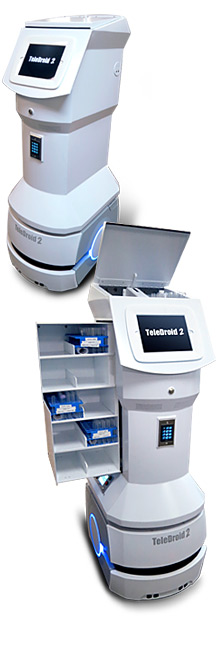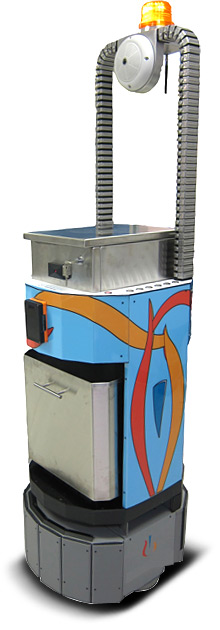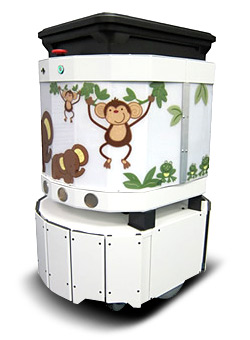Case Studies
Quest Diagnostics Forensic Lab in Tucker, Georgia
The Task: Develop an autonomous mobile robot that can transport forensic specimens inside secure containers in compliance with chain-of-custody protocols within in 40,000 square foot Quest Diagnostics Forensic Lab located in Tucker, Georgia.
The Solution: “BrAtLe”, the name selected by the members of the Quest Team for the TeleDroid 2 Transporter AMR, transports forensic specimens to lab-stations, and “calls” and “rides” an elevator between floors. The forensic specimens are carried inside two on-board containers, each of which is opened by an electrically powered articulating arm system when an access code is entered by a lab technician using the digital keypad.
- When BrAtLe was delivered, he created an on-board laser map of the environment in which he provides service, and the Quest Team determined the location of each of the “goals” to which BrAtLe is sent to pick-up or deliver forensic specimens. These goals are displayed on the on-board iPad “touch-screen” interface, and on remote iPads that are configured with the Robolytics TeleDroid 2 Controller App, which enables these iPads to “call” or “send” BrAtLe, via the secure wireless network within the facility.
- BrAtLe compiles on-board log-files of every move he makes, which include a time and date stamp of each trip; each pick-up and drop-off; and each security code entered by a lab technician.
- BrAtLe is powered by a navigation/drive platform, which enables him to provide service within the Quest Diagnostics Forensic Lab in Tucker, Georgia without disrupting employees or procedures; reliably navigates within designated areas and utilize alternate routes if necessary; and, circumvents moving and stationary obstacles within areas in which it operates. An on-board rechargeable lithium-ion phosphate battery system, with a 7-year life, provides 8 hours of runtime, and a 6:1 recharge rate from a charging dock that plugs into a standard 110V AC outlet.
- BrAtLe is configured to wirelessly activate automatic door openers, and call and ride an elevator between the 1st and 2nd floor of the lab.

Novartis Consumer Health in Lincoln, Nebraska
The Task: Design a fully autonomous mobile robot capable of operating 24/7, 365-days/year within a 1.2 million square foot manufacturing facility, to transport production samples, in compliance with DEA protocols and regulations, in open and locked bins, from several production-lines to in-house quality assurance labs; and, locate batch-records within the facility, when and as required. “Sam” is the name selected by Novartis for this AMR.
- “Sam”, a fully autonomous mobile robot, is powered by a navigation and transport base which enables him to provide service throughout the Novartis facility without disrupting employees or procedures; reliably navigate within designated areas and utilize alternate routes if necessary; and, circumvent moving and stationary obstacles within areas in which he operates.
- When delivered, “Sam” created an on-board laser map of the routes that would enable him to travel to-and-from his “goals”. An on-board wireless interface enabled selected doorways to be opened to allow him with access to secure areas, and, an on-board RF-ID reader system enabled him to identify the location throughout the facility of RF-ID active-tags attached to production “batch records”.
- Access to “Sam’s” container that transports products containing “controlled” substances bin requires the “swipe” of an authorized proximity card to open. An on-board log-file is created of each “swipe” that consists of the name of the employee name associated with the badge swipe and a date/time stamp indicating when the container was opened. Additionally, an on-board 180° video camera is activated each time someone accesses the locked container, or, in the event someone tampers with “Sam”.
- Products that do not contain controlled substances are automatically loaded into “Sam” from an “articulating shelf” designed by the Robolytics team, into a drawer that extends from his torso when he arrives at the pick-up zone.
- “Sam” can follow a “programmed route”, or can be “called” to selected locations throughout the facility “on demand” via a Robolytics Wireless Call Box, and returns to his “docking station” to recharge his batteries between pick-ups and deliveries.

Children’s Mercy Hospital & Clinics, Kansas City, MO
The Task: Develop an autonomous mobile robot to operate within a central lab at Children’s Mercy Hospital & Clinics capable of transporting specimens from the “accessioning” desk to six “stations” located within the lab.
- “Scooter”, which is the name selected for this robot by the lab staff, is fully autonomous, a navigation and transport base which enables him to provide service throughout the CMH lab without disrupting employees or procedures; reliably navigate within designated areas and utilize alternate routes if necessary; and, circumvent moving and stationary obstacles within areas in which they operate.
- “Scooter” is in operation 24/7 365 days/year, follows a programed route, and can also be “called” to a “station”, via a Robolytics wireless call box.
- “Scooter” was configured to compile on-board log-files that record the time and date of each pick-up and delivery, enabling the facility manager to determine the most efficient delivery routes in relationship to “processing loads”, and available “staff”.
- “Scooter” returns to his “docking station” to recharge his batteries between pick-ups and deliveries.

